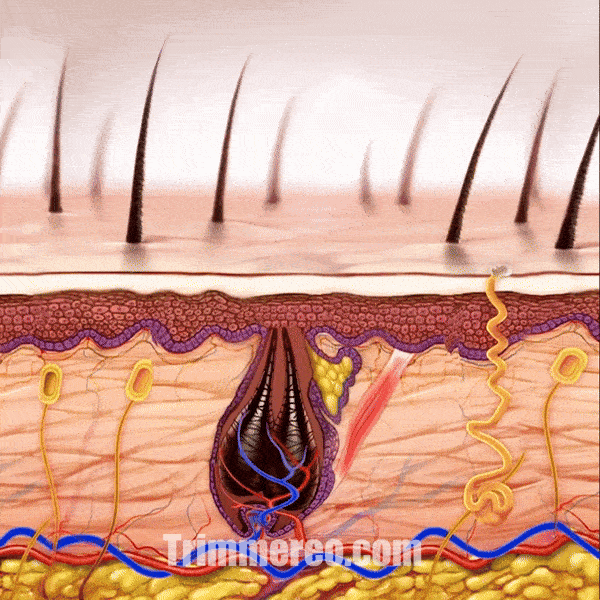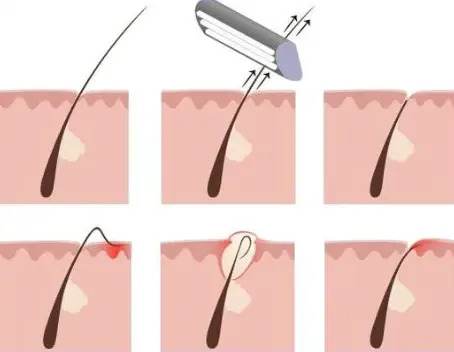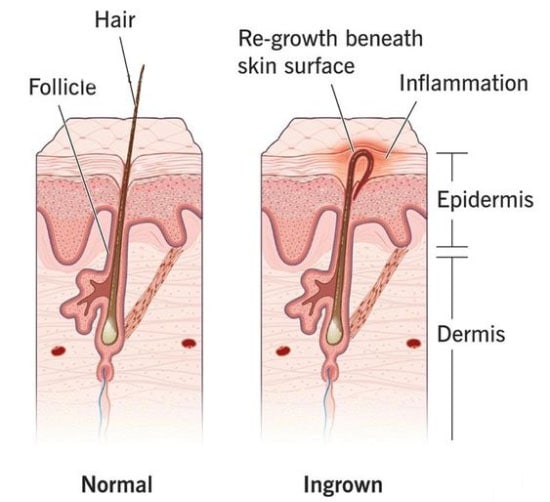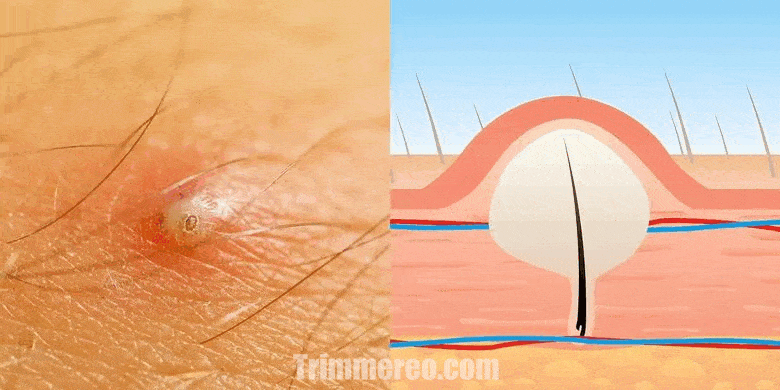Do you hate dealing with annoying ingrown hairs after using an electric shaver? The answer is Electric shavers themselves don’t cause ingrown hairs, but improper techniques or dull blades can contribute to the problem.
Wait, You’re not alone. Lots of people go through this frustrating problem, but only some know why it happens.
Are electric shavers causing those ingrown hairs? How can you stop ingrown hairs when using an electric shaver? Should you pick an electric shaver or a manual razor to avoid ingrown hairs?
What are signs that your electric shaver is causing ingrown hairs? Can you treat ingrown hairs if they happen after using an electric shaver?
In this article, we’ll look into the link between electric shavers and ingrown hairs. We’ll also give you expert tips on preventing them.
Whether you’re experienced or just starting, this info is important for getting a smooth shave without ingrown hair troubles. So, let’s find out the truth about electric shavers and ingrown hairs.
What Are Ingrown Hairs?
As someone who’s had ingrown hairs, I know how irritating and uncomfortable they are.
But what exactly are they?
An ingrown hair is a hair that has grown back into the skin instead of rising up from the hair follicle normally. It often happens after shaving, waxing, or plucking hair.
When the hair curls back or grows sideways into the skin, it can cause a small, raised bump that might be red or painful. Sometimes, you can see the hair trapped under the skin.
Ingrown hairs can pop up anywhere hair grows, but they’re most common in places you shave or wax, like the face, neck, underarms, legs, and bikini area.
Several things can cause ingrown hairs, including curly or thick hair, shaving too closely or against the grain, dead skin cells blocking hair follicles, tight clothing, or irritating skin products.
If left untreated, they can get infected, leading to more serious problems. That’s why it’s important to prevent and treat them early.

What Are The Main Causes of Ingrown Hairs?
As someone who’s struggled with ingrown hairs, I know how annoying they can be. While there are many things that can cause ingrown hairs, a few common ones are worth mentioning.
Shaving with Dull Blades
One of the top causes of ingrown hairs is shaving with dull blades. When the blades are dull, they can tug on the hair instead of cutting it cleanly. This can make the hair grow back into the skin.
Shaving Against the Grain
Shaving against the grain can also lead to ingrown hairs. Even though it might give you a closer shave, it can make the hair grow back into the skin because it’s cut at an angle.
Excessive Pressure or Irritation
Putting too much pressure or irritating your skin can also cause ingrown hairs. Pressing too hard or shaving too roughly can irritate your skin, making the hair grow back into it.
Curly or Coarse Hair
Curly or coarse hair is more likely to become ingrown because it tends to curl back into the skin as it grows.
Some other things can lead to ingrown hairs:
- Shaving Too Closely: When you shave too closely, you might cut the hair below the skin’s surface, causing it to grow inward as it regrows.
- Dead Skin Cells: If dead skin cells block the hair follicle opening, the hair can’t grow out normally, so it curls back into the skin.
- Tight Clothing: Wearing tight clothing can cause friction against the skin, pushing hairs back into the follicles.
- Improper Hair Removal: If you don’t remove hair properly, like with waxing, tweezing, or plucking, the hair can break off unevenly and grow inward as it regrows.
Ingrown hairs aren’t usually serious, but they can be irritating and sometimes get infected, causing more pain and redness. It’s essential to treat ingrown hairs gently to avoid further irritation or infection.
To avoid ingrown hairs, make sure to use a sharp blade, shave with the grain, avoid putting too much pressure, and be aware of your hair type. By following these steps, you can lower your chances of getting ingrown hairs and have smoother, healthier skin.

What Are Razor Bumps?
As someone who’s dealt with ingrown hairs, I know how annoying and uncomfortable they can be.
Razor bumps, also called pseudofolliculitis barbae, happen when hair curls back into the skin instead of growing straight out. This can occur if the hair is cut too short or if the hair follicle gets irritated or inflamed.
These bumps usually look like small red or pink bumps on the skin and can feel itchy or painful. They’re most common in areas where you regularly shave, like the face, neck, legs, and bikini area.
While razor bumps aren’t a serious medical issue, they can be bothersome and, sometimes, lead to scarring or infection.
Several things can contribute to getting razor bumps:
- Shaving too closely or often
- Using a dull or dirty razor
- Shaving against the direction of hair growth
- Having curly or coarse hair
- Having sensitive skin
- Using harsh shaving products
If you’re prone to razor bumps, there are steps you can take to prevent them. First, make sure to use a clean, sharp razor and shave in the direction your hair grows.
Consider using shaving products made for sensitive skin and avoid those with alcohol or harsh ingredients. Also, remember to moisturize your skin regularly to keep it healthy and hydrated.
How Do Electric Shavers Work?
As someone who’s used electric shavers for a while, I can tell you they’re convenient and easy to use. But have you ever wondered how they actually work?
Electric shavers usually come in two types: foil or rotary. Foil shavers have a thin metal foil covering the blades to catch the hair as it’s cut. Rotary shavers have spinning blades that move in a circular motion to cut the hair.
Both types have an electric motor powering the blades, creating a rapid back-and-forth or circular motion to move them across the skin and cut the hair.
One advantage of electric shavers is you can use them dry or wet with shaving cream or gel. Wet shaving might give you a closer shave because the cream or gel can lift the hairs, providing a smoother surface for the blades.
Overall, electric shavers are a convenient and efficient way to shave. While they might not give you as close a shave as traditional razors, they’re great for saving time and skipping the hassle of lathering up with shaving cream.
Do Electric Shavers Cause Ingrown Hairs?
As someone who’s had ingrown hairs, I wondered if electric shavers could be to blame.
After some research, here’s what I found:
Advantages of Electric Shavers:
- They’re convenient and easy to use.
- Less likely to cause cuts and nicks.
- Can be used on wet or dry skin.
- Don’t need shaving cream or gel, which is good for sensitive skin.
Disadvantages of Electric Shavers:
- They can cause ingrown hairs because they cut hair at a different angle than traditional razors, sometimes making it too short and causing it to curl back into the skin.
- They can also irritate the skin, leading to redness and inflammation, which can contribute to ingrown hairs.
To minimize the risk of ingrown hairs when using an electric shaver, use the correct shaving technique, avoid pressing too hard on the skin, and keep the shaver clean to prevent bacteria buildup.

Preventing Ingrown Hairs:
As someone who’s struggled with ingrown hairs, I know how frustrating and painful they can be.
Here are some steps to prevent them when using an electric shaver:
- Exfoliate Regularly: Get rid of dead skin cells and debris that can block hair follicles. You can do this by gently scrubbing your skin with a loofah, scrub, or exfoliating brush before shaving.
- Use a Sharp Blade: Make sure your razor blade is sharp. Dull blades can pull and twist hair, causing it to grow back into your skin. Replace your blades regularly for a clean shave.
- Lubricate Your Skin: Before shaving, lubricate your skin with shaving cream, gel, or oil. This helps your razor glide smoothly over your skin, reducing irritation and the chance of ingrown hairs.
- Choose the Right Electric Shaver: Pick an electric shaver that suits your skin type and hair texture. Some shavers have adjustable settings for a customized shave. Find one that works best for you.
By following these tips, you can prevent ingrown hairs when using an electric shaver. Remember to exfoliate, use a sharp blade, lubricate your skin, and choose the right shaver for a smooth and irritation-free shave.
How to Treat Ingrown Hairs:
If you have ingrown hair, you can treat it at home with some simple steps. Here’s what you can do:
- Clean the Affected Area: Start by washing the area with mild soap or cleanser to remove dirt and bacteria. Rinse well with warm water and pat dry with a clean towel.
- Apply Heat: Using a warm compress, like a warm washcloth, or taking a warm bath or shower can help reduce inflammation and promote healing. Just make sure the water isn’t too hot to avoid irritating your skin.
- Use an Exfoliating Scrub: Exfoliating helps remove dead skin cells and prevent future ingrown hairs. Use a gentle scrub or exfoliating brush to loosen the hair and allow it to grow out properly. Avoid harsh scrubs to prevent skin damage.
- Use Antibiotics or Retinoids: If the ingrown hair gets infected, your doctor may prescribe antibiotics or retinoids to clear up the infection and prevent complications. Follow your doctor’s instructions carefully.
Remember to be gentle with the affected area and avoid picking or squeezing the hair to prevent further irritation and scarring.
How to Treat Razor Bumps:
If you’re dealing with razor bumps, there are a few things you can do to treat them:
- Apply Tea Tree Oil or Witch Hazel: These natural remedies can soothe and reduce inflammation on irritated skin. Apply a few drops to a cotton ball and gently dab it onto the affected area.
- Use a Facial Scrub: Look for a gentle facial scrub containing glycolic or salicylic acid to exfoliate the skin and prevent ingrown hairs. Use it once or twice a week to keep your skin smooth and healthy.
- Hydrate Your Skin: Moisturizing is essential for preventing razor bumps. Use a moisturizer with hyaluronic acid to lock in moisture and prevent dryness after shaving.
Treating razor bumps involves gentle exfoliation, anti-inflammatory ingredients, and proper hydration to prevent ingrown hairs and maintain healthy skin. These tips can help you achieve smooth, bump-free skin.
FAQs:
Can electric shavers cause ingrown hairs?
Electric shavers themselves don’t cause ingrown hairs, but improper techniques or dull blades can contribute to the problem.
How can I prevent ingrown hairs with an electric shaver?
Prepare your skin by exfoliating and using pre-shave oil. Use a quality electric shaver with sharp blades and shave in the direction of hair growth.
Should I use an electric shaver or a manual razor to prevent ingrown hairs?
Both can work, but electric shavers may be better for sensitive skin or those prone to razor burn.
What are signs my electric shaver is causing ingrown hairs?
Look for redness, irritation, or bumps after shaving. Adjust your technique or try a different shaver if you experience these symptoms.
Can ingrown hairs from electric shavers be treated?
Yes, you can treat them with gentle exfoliation, warm compresses, and topical creams to prevent infection.
Are there any special precautions for using an electric shaver?
Yes, there are a few precautions to keep in mind when using an electric shaver. Make sure your skin is clean and properly lubricated before shaving to reduce friction and irritation.
Also, avoid pressing too hard on the skin and always shave in the direction of hair growth to minimize the risk of ingrown hairs.
Can ingrown hairs lead to scarring?
In some cases, ingrown hairs can lead to scarring, especially if they become infected or are repeatedly irritated. It’s essential to treat ingrown hairs promptly and avoid picking or squeezing them to reduce the risk of scarring.
What should I do if I develop a severe reaction to shaving?
If you experience a severe reaction to shaving, such as excessive redness, swelling, or persistent pain, it’s essential to stop shaving and seek medical attention.
A healthcare professional can assess your symptoms and recommend appropriate treatment to help alleviate discomfort and prevent further complications.
Are there any long-term solutions for preventing ingrown hairs?
Yes, there are several long-term solutions for preventing ingrown hairs, such as laser hair removal or electrolysis.
These treatments target the hair follicles, reducing hair growth and the risk of ingrown hairs over time. However, they may require multiple sessions and can be costly.
Can ingrown hairs be a sign of an underlying skin condition?
In some cases, recurrent ingrown hairs may be a sign of an underlying skin condition, such as folliculitis or keratosis pilaris.
If you continue to experience ingrown hairs despite following proper shaving techniques and skincare practices, it’s essential to consult a dermatologist for further evaluation and management.
Final Words
In conclusion, taking proper care when shaving with an electric shaver and following these tips can help minimize the risk of ingrown hairs and maintain healthy skin.
If you experience persistent issues or severe reactions, don’t hesitate to seek medical advice for personalized treatment and guidance.

Bradley Martyn – Grooming Expert with 20+ years of first‑hand experience testing electric shavers in the United Kingdom, United States, and United Arab Emirates. My reviews are based on rigorous, real‑world testing and a commitment to transparent, unbiased insights.
Our Testing MethodologyI personally evaluate each shaver through multiple shave cycles, both wet (with cream or gel) and dry, assessing closeness, comfort on sensitive skin, battery endurance, and ease of cleaning.
If you found the information useful, consider subscribing to the Trimmereo newsletter as well. It’s free and I only send a few emails per month. Unsubscribe at any time.

